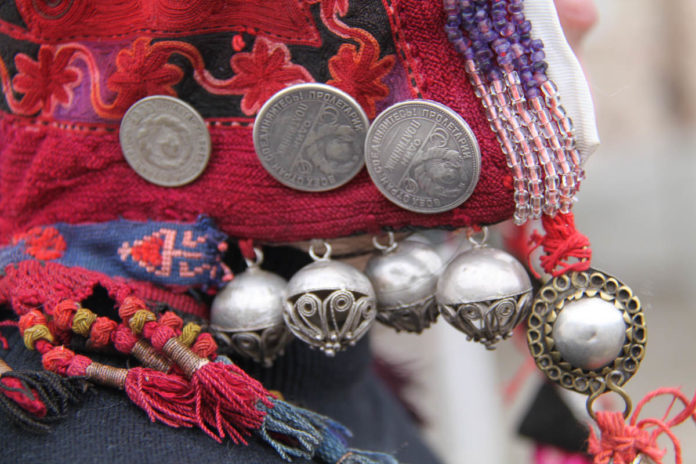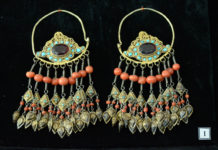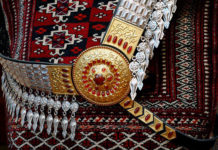
The art of jewellery making among Kyrgyz people goes back to ancient times. The favourite and common precious metal among the Kyrgyz was silver. From silver and its alloys, jewellers created women’s jewellery, details of men’s leather belts and horse harness.
Jewellery has always been an integral part of the national costume. Wearing jewellery was regulated in accordance with age, family and social status. Wealthy men wore wide belts (kemer kur) with silver details. The subject of special pride was richly decorated horse harness and hunting equipment, as well as weapons.

The most common female jewellery included earrings (soyko); simple in shape rings (shakek), that often had oval or diamond-shaped centerpiece; curled, round or flat bracelets (bilerik); buttons (topchu), used both to button and to decorate clothes; temporal and breast adornments worn on solemn occasions; and braid adornments of married women (chach uchtuk).
Masters used a variety of techniques for finishing products: inlay, denting, embossing, stamping, openwork carving, granulation, blackening and gilding. Granulation technique was present on the territory of modern day Kyrgyzstan in the first millennium B.C., during the Saka period. In combination with inlay, it was used in the decoration of earrings and rings. Denting was done with the help of steel rods that had different elements of the pattern at the tip: in the form of a crescent, an asterisk, a nail-shaped oval, a point, a triangle and a square. The technique of blackening the pattern or its background was usually used in combination with engraving mainly in the north of Kyrgyzstan. In the southern regions, the technique of stamping hollow jewellery, usually consisting of two halves, was popular. In that case, the matrix was made from horn of a mountain goat or a sheep, and the stamp was made of hard metal.
Gilding and precious stones in Kyrgyz jewellery were rarely used. Of semi-precious stones, turquoise and carnelian, as well as mother of pearl and corals, were used most often. Sometimes smalt was used.
Decoration of silver items included pagan symbols of sky, earth and water, various solar, cosmogonic signs and magical motives of animal and vegetative world.
Jewellery art, which was often combined with blacksmithing, was predominantly male craft, but female jewellers (zerger) are also known. Jewellery from silver is in great demand still, in modern day Kyrgyzstan. Renown jewellers include Jakshylyk Chentemirov, Ryspek Shambetakunov and Zhanyl Sharshembiyeva.




